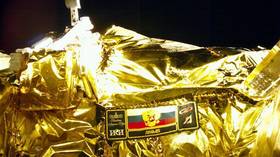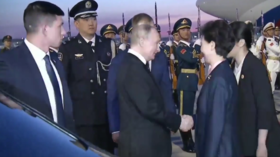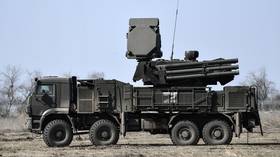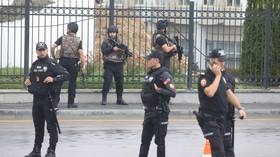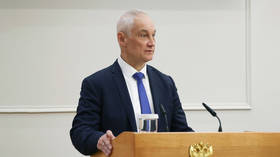First picture by Russia’s historic lunar probe released (IMAGE)
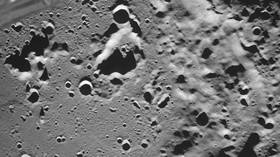
The automatic interplanetary station Luna-25 has sent back its first photographs of a polar crater on the far side of the Moon, Roscosmos revealed on Thursday. The first Russian Moon probe in 47 years is scheduled to make lunarfall next week.
The breakthrough images were of the enormous Zeeman crater, featuring sides which rise almost 8km (5 miles) above the lunar surface. Being on the part of the Moon perpetually faced away from Earth, the crater is not observable by astronomers.
“The image taken today at 08:23 Moscow time shows the south polar crater Zeeman on the far side of the Moon. The coordinates of the center of the crater correspond to 75 degrees south latitude and 135 degrees west longitude,” a Roscosmos statement confirmed. “The images obtained significantly complement the currently available information about this crater.”
The imagery was created using the STS-L television camera complex, created by the Space Research Institute of the Russian Academy of Sciences. Luna-25 has also carried out measurements of gamma ray and neutron flux from the surface of the Moon, as well as the parameters of circumlunar space plasma and the gas and dust exosphere in the circumlunar orbit, Roscosmos noted.
Luna-25 is the first Moon probe undertaken by modern Russia, entirely from domestic components. It was developed by the S. A. Lavochkin Scientific and Production Association. Launched on August 11, it aims to become the first spacecraft to achieve a soft landing in the south polar region of Earth’s satellite, scheduled to take place on or around August 21.
The main goal of the mission is to examine lunar soil for the presence of ice, but Roscosmos said it also wants to test soft landing technology and conduct long-term research on the lunar exosphere and the upper layer of regolith of the Moon’s south pole.
The launch of Luna-25 from the Vostochny cosmodrome in the Amur Region signaled Russia’s return to lunar exploration after a hiatus of 47 years. The original Luna program began in the Soviet Union and completed 24 successful missions to the Moon between September 1958 and August 1976.
